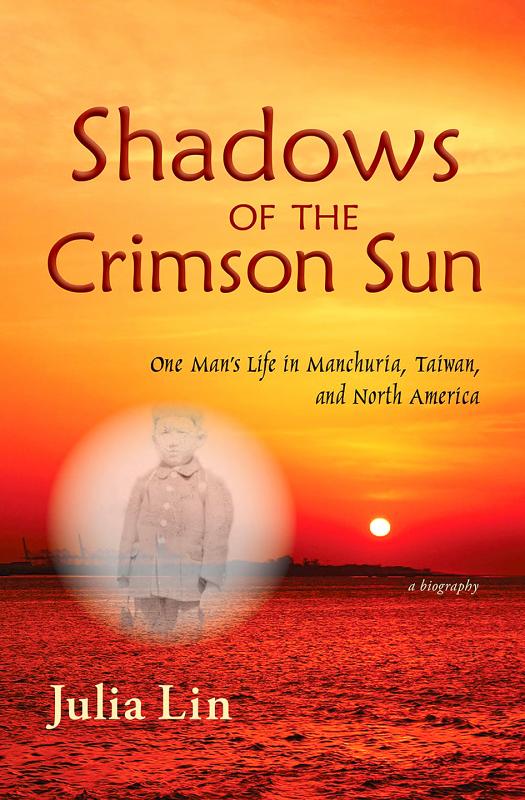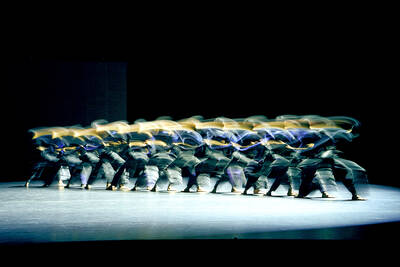I’m informed that it’s taken for granted by writers that there are too many memoirs — the market’s saturated and they’re as a result unpublishable. Julia Lin’s Shadows of the Crimson Sun is part-memoir but also part-novel. In addition, it was published over three years ago, and by a small, independent Canadian publisher.
It tells of the life of Charles Yang, who was born Yang Cheng-chau, and his migration from the former Japanese puppet-state of Manchuria back to Taiwan, and thence to North America.
Born in Taiwan in 1932, his family moved to Manchuria two years later. He left to return to Taiwan aged 14 following the defeat of Japan in World War II and Manchuria’s invasion by the Soviet Union. Around 5,000 elite Taiwanese made their homes in Japanese Manchuria between 1931 and 1945, adopting Japanese names. Charles’s father was one of them, settling in what is now China’s Shenyang, Liaoning Province.

In saying this book is part-novel I don’t mean to imply that anything is invented. Rather, it’s the style that is quasi-fictional, the presentation of a real-life story without the paraphernalia of too many notes. A great vividness is thereby attained, not least about Taiwan under Chinese Nationalist Party (KMT) rule, and then life and radical activism in Canada (calling for political reform in Taiwan) by one of the early Taiwanese-Canadians to settle in Vancouver.
The detail is extraordinary. No other book I know has made Japanese Manchuria spring to life in the way Julia Lin (who was born in Taiwan) does here, with the Japanese-Russian hostility in the region especially vividly presented. And she proceeds to exhibit a similarly extensive command of life in the periods relevant to her story in Taiwan, the US and western Canada. The result is an enthralling narrative featuring Taiwan and some of the many places that Taiwanese have migrated to.
It’s tempting to linger over this book’s riveting Manchurian chapters, but readers will be keen to know what happens when Charles Yang gets to Taiwan, and later North America, so we must move on.
Yang stayed in Taiwan from 1946 to 1959, enrolling at the Tainan First High School, his father’s alma mater. Taiwan was then a place of paradoxes. On the one hand it enjoyed one of the highest standards of living in East Asia, while on the other women could still be seen hobbling around with bound feet. But above all, it was experiencing the White Terror, the KMT’s way of repressing opposition. The usual items are gone through: the 228 Incident (far more than an “incident”), political trials, imprisonment on Green Island and so on. Lin quotes an estimate of summary executions during this period as being as high as 45,000.
In Manchuria, Yang had felt inferior for not being Japanese. Now in Taiwan he felt similarly for not being a Mainlander, or those who fled to Taiwan with the KMT following its defeat in the Chinese Civil War. Nevertheless, by 1951 he was enrolled at Taipei’s National Taiwan University as a medical student, on a seven-year program. There he became a Christian and, in 1957, married Wang Ai-chen, or “Jane” (also from Manchuria), in a Christian ceremony.
Then, in 1959, Yang took a flight, via Midway, Guam and Hawaii, to San Francisco, to take up an offer of an internship in Chicago, to be followed by one in Detroit. The Taiwanese government only allowed emigration after candidates had completed their military service, but Yang had been exempted on account of his severe myopia. Jane initially stayed in Taipei, but joined her husband in 1962 after he had accumulated enough funds to satisfy the US immigration requirements. The Yangs now had to start a new life, and to learn English.
The couple also began to develop feelings for Taiwanese independence, and anger at the injustices of KMT rule. The radicalism that was engulfing the US in the 1960s only served to fuel these sentiments. But then Charles Yang’s US visa expired. He responded by moving to Canada, becoming one of the first Taiwanese immigrants to Vancouver.
He also became a more serious political radical. In 1970, there was an attempt to assassinate Chiang Ching-kuo (蔣經國), at the time Taiwan’s vice-premier, when he was on a state visit to the US. Charles Yang contributed a month’s salary to the would-be assassin’s defense fund, and appeared on TV in Seattle to defend the protest movement. This was a risky move. Defiance, even in far-away Canada, could result in jail, torture and even murder of family members back home in Taiwan. But Charles’s immediate family were all now in North America. He did try, twice, to re-visit Taiwan but was luckily denied the necessary documents. Others in his position had gone but had never returned.
In British Columbia life was not without its problems. The Canadian province had a history of anti-Chinese racism, though measures to reverse this were to begin in the 2000s. But even some Taiwanese immigrants retained language-based prejudice, such as that of Hokkien-speakers vis-a-vis the others. Differences between immigrants from Taiwan, China, Hong Kong, Singapore and Malaysia only added to the mix. Yang responded by becoming active in the Vancouver Taiwanese Presbyterian Church.
Charles’s wife died in 2010. Vancouver remained one of the world’s most desirable cities to live in. Over 100,000 Taiwanese have gained Canadian citizenship, with the largest community living in Vancouver. Moreover, the 2014 Sunflower protest movement gave Charles new hope for Taiwan’s future.
The book’s last chapter is a depressing account of the afflictions of old age as experienced by Yang. Doctors aren’t exempt from the shocks that flesh is heir to, after all.
It seems to me extraordinary that this book, on sale at a very cheap price (under three US dollars), both in Kindle and paperback format, isn’t better known. It’s both authoritative — the author spent three years on her research — and gripping. Clearly Charles Yang provided a wealth of personal information, but Julia Lin has in addition researched her background with enormous thoroughness, making this a book I will long return to and remember.

Most heroes are remembered for the battles they fought. Taiwan’s Black Bat Squadron is remembered for flying into Chinese airspace 838 times between 1953 and 1967, and for the 148 men whose sacrifice bought the intelligence that kept Taiwan secure. Two-thirds of the squadron died carrying out missions most people wouldn’t learn about for another 40 years. The squadron lost 15 aircraft and 148 crew members over those 14 years, making it the deadliest unit in Taiwan’s military history by casualty rate. They flew at night, often at low altitudes, straight into some of the most heavily defended airspace in Asia.

Beijing’s ironic, abusive tantrums aimed at Japan since Japanese Prime Minister Sanae Takaichi publicly stated that a Taiwan contingency would be an existential crisis for Japan, have revealed for all the world to see that the People’s Republic of China (PRC) lusts after Okinawa. We all owe Takaichi a debt of thanks for getting the PRC to make that public. The PRC and its netizens, taking their cue from the Chinese Communist Party (CCP), are presenting Okinawa by mirroring the claims about Taiwan. Official PRC propaganda organs began to wax lyrical about Okinawa’s “unsettled status” beginning last month. A Global

Taiwan’s democracy is at risk. Be very alarmed. This is not a drill. The current constitutional crisis progressed slowly, then suddenly. Political tensions, partisan hostility and emotions are all running high right when cool heads and calm negotiation are most needed. Oxford defines brinkmanship as: “The art or practice of pursuing a dangerous policy to the limits of safety before stopping, especially in politics.” It says the term comes from a quote from a 1956 Cold War interview with then-American Secretary of State John Foster Dulles, when he said: ‘The ability to get to the verge without getting into the war is

Like much in the world today, theater has experienced major disruptions over the six years since COVID-19. The pandemic, the war in Ukraine and social media have created a new normal of geopolitical and information uncertainty, and the performing arts are not immune to these effects. “Ten years ago people wanted to come to the theater to engage with important issues, but now the Internet allows them to engage with those issues powerfully and immediately,” said Faith Tan, programming director of the Esplanade in Singapore, speaking last week in Japan. “One reaction to unpredictability has been a renewed emphasis on